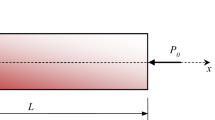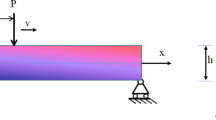Abstract
To study the location of crack initiation and its failure mode in the Brazilian test, the analytical location of the crack initiation under different failure modes was first discussed with the stress formulas of the Brazilian test. Then, by using the numerical simulation technique of fast Lagrangian analysis of continua to simulate the ideal Brazilian test, we found that: (a) when the crack was a tensile fracture, the crack initiation point was found to be around the maximum tension stress point; (b) when the crack was a shear failure, the crack initiation point, which was only related to the internal friction angle, was found between the maximum tension stress point and the tensile critical point; and c. the numerical conclusion well verified the correctness of the theoretical analysis and was in good agreement with the results of other papers.






Similar content being viewed by others

References
Akazawa T (1943) New test method for evaluating internal stress due to compression of concrete (the splitting tension test)(part 1). J Jpn Soc Civ Eng 29:777–787
Aydin A, Basu A (2006) The use of Brazilian test as a quantitative measure of rock weathering. Rock Mech Rock Eng 39:77–85
Barla G, Innaurato N (1973) Indirect tensile testing of anisotropic rocks. Rock Mech 5:215–230
Carneiro F (1943) A new method to determine the tensile strength of concrete. Proceedings of the 5th meeting of the Brazilian Association for Technical Rules Portuguese. pp 126–129
Exadaktylos G, Kaklis K (2001) Applications of an explicit solution for the transversely isotropic circular disc compressed diametrically. Int J Rock Mech Min Sci 38:227–243
Muskhelishvili NI (1953) Some basic problems of the mathematical theory of elasticity. Cambridge Univ Press, Cambridge
Steen BVD, Vervoort A, Napier J (2005) Observed and simulated fracture pattern in diametrically loaded discs of rock material. Int J Fract 131:35–52
Yanagidani T, Sano O, Terada M, Ito I (1978) The observation of cracks propagating in diametrically-compressed rock discs. Int J Rock Mech Min Sci Geomech Abstr 15:225–235
(1978) Suggested methods for determining tensile strength of rock materials. International Journal of Rock Mechanics and Mining Sciences & Geomechanics Abstracts 15: 99–103
Fairhurst C (1964) On the validity of the ‘Brazilian’test for brittle materials. Int J Rock Mech Min Sci Geomech Abstr 1:535–546
Gong F, Li X, Zhao J (2010) Analytical algorithm to estimate tensile modulus in Brazilian disk splitting tests. Yanshilixue Yu Gongcheng Xuebao/Chin J Rock Mech Eng. 29:881–891
Jaeger JC, Cook NG, Zimmerman R (2009) Fundamentals of rock mechanics. Wiley. com, Hoboken
Li D, Wong LNY (2013) The Brazilian disc test for rock mechanics applications: review and new insights. Rock Mech Rock Eng 46:269–287
Markides CF, Kourkoulis S (2012) The stress field in a standardized brazilian disc: the influence of the loading type acting on the actual contact length. Rock Mech Rock Eng 45:145–158
Markides CF, Pazis D, Kourkoulis S (2010) Closed full-field solutions for stresses and displacements in the Brazilian disk under distributed radial load. Int J Rock Mech Min Sci 47:227–237
Wang QZ, Xing L (1999) Determination of fracture toughness KIC by using the flattened Brazilian disk specimen for rocks. Eng Fract Mech 64:193–201
Wang Q, Jia X, Kou S, Zhang Z, Lindqvist P-A (2004) The flattened Brazilian disc specimen used for testing elastic modulus, tensile strength and fracture toughness of brittle rocks: analytical and numerical results. Int J Rock Mech Min Sci 41:245–253
Xu NX, Tian H, Kulatilake P, Duan QW (2011) Building a three dimensional sealed geological model to use in numerical stress analysis software: a case study for a dam site. Comput Geotech 38:1022–1030
Yu Y (2005) Questioning the validity of the Brazilian test for determining tensile strength of rocks. Chin J Rock Mech Eng 24:1150–1157
Yu Y, Xu YL (2006) Method to determine tensile strength of rock using flattened Brazilian disk. Chin J Rock Mech Eng 25:1457–1462
Acknowledgments
This paper gets its funding from Project (51304240) supported by National Natural Science Foundation of China; Project (20120162120014) supported by the Specialized Research Fund for the Doctoral Program of Higher Education of China; Project (KLE-TJGE-B1305) supported by Open Fund of Key Laboratory of Geotechnical and Underground Engineering (Tongji University), Ministry of Education. The authors wish to acknowledge these supports.
Author information
Authors and Affiliations
Corresponding author
Rights and permissions
About this article
Cite this article
Lin, H., Xiong, W., Zhong, W. et al. Location of the Crack Initiation Points in the Brazilian Disc Test. Geotech Geol Eng 32, 1339–1345 (2014). https://doi.org/10.1007/s10706-014-9800-5
Received:
Accepted:
Published:
Issue Date:
DOI: https://doi.org/10.1007/s10706-014-9800-5



